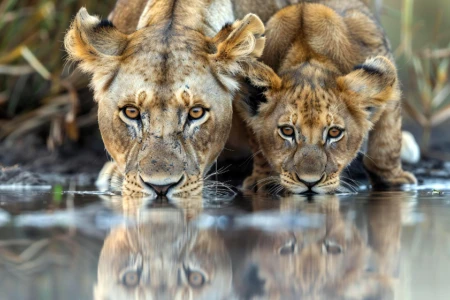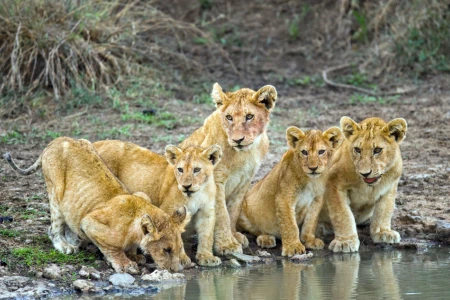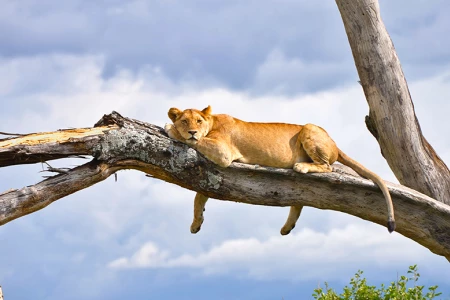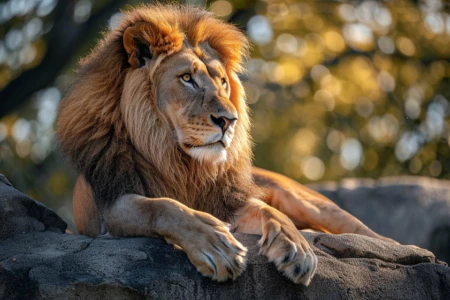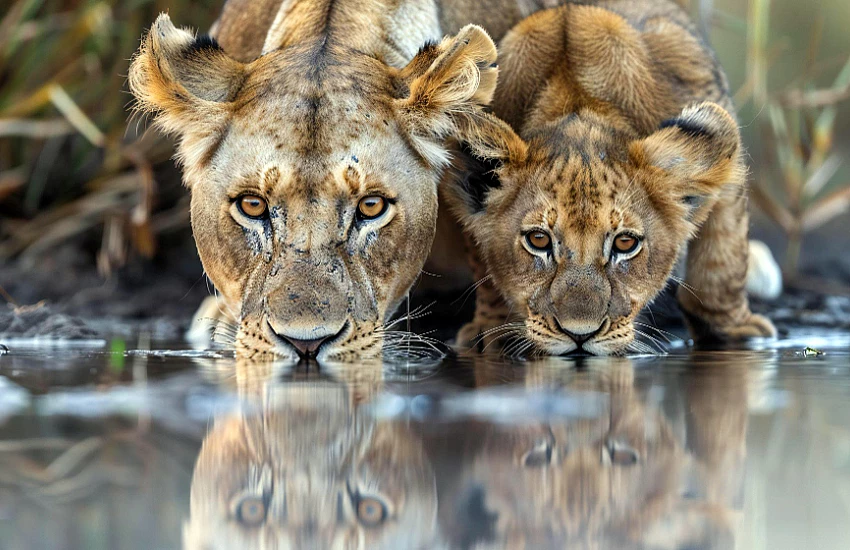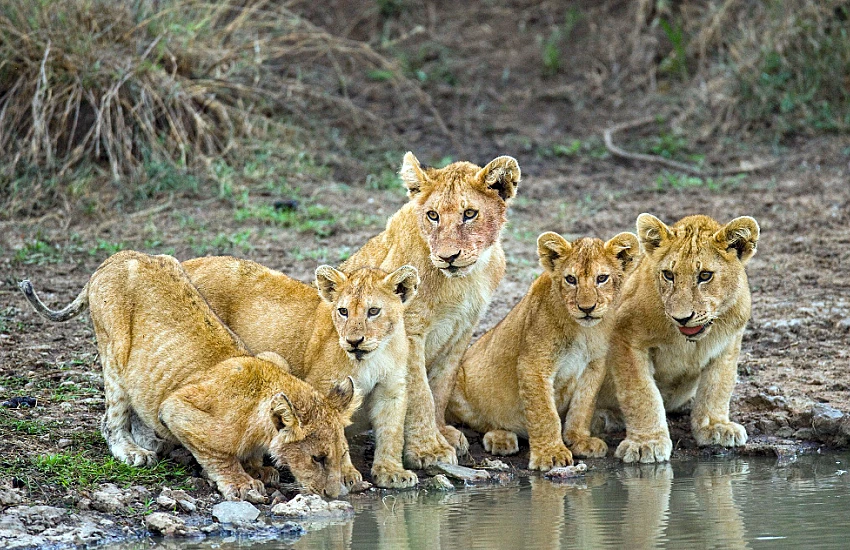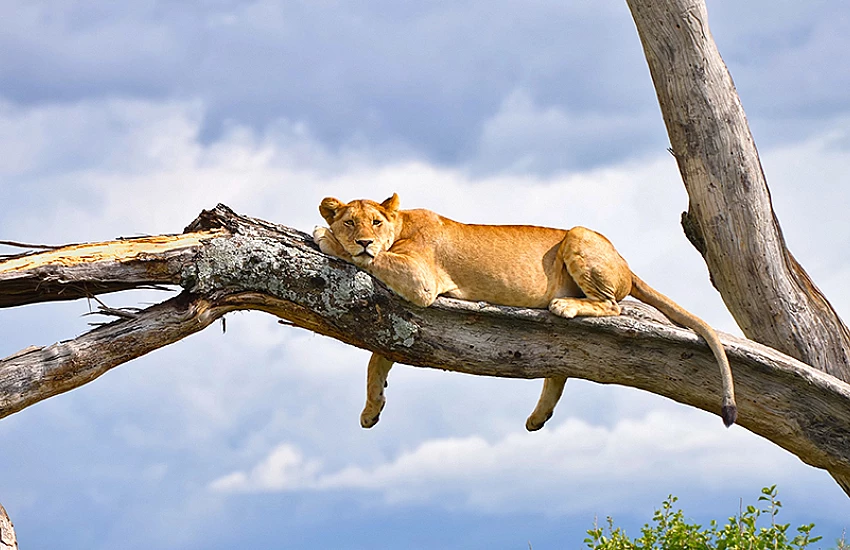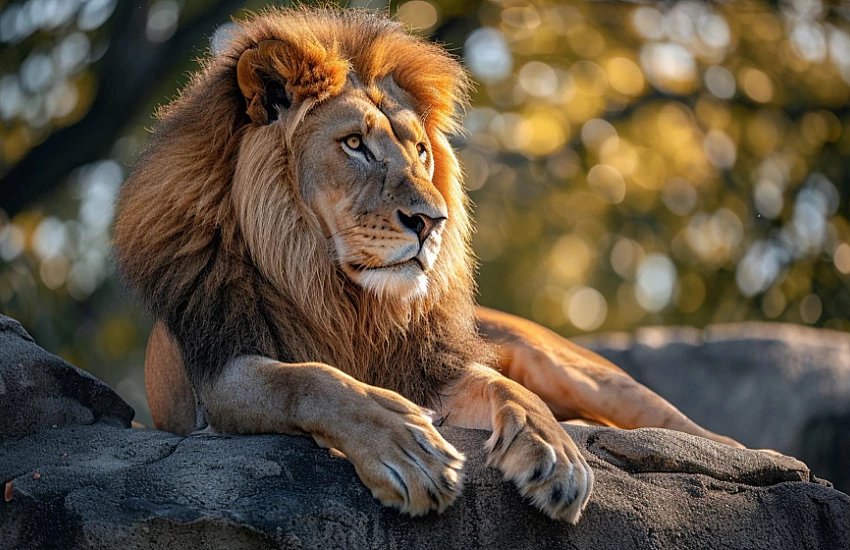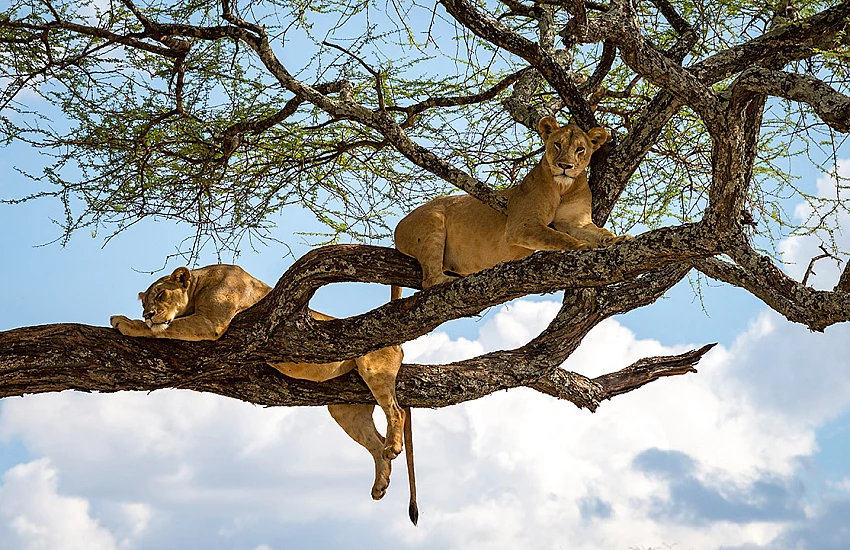
Tabla de contenidos
The unique behavior of tree-climbing lions in Lake Manyara has captivated both scientists and tourists alike, standing out as a fascinating anomaly in the animal kingdom. Unlike their counterparts in other parts of Africa, these lions have developed a peculiar habit of climbing and lounging on trees, a behavior more commonly associated with leopards. This arboreal activity offers several intriguing insights into the adaptive nature of these majestic predators.
One prevailing theory suggests that the lions climb trees to escape the oppressive heat of the ground during scorching midday temperatures. Elevated positions on tree branches provide cooler breezes and shade, offering respite from the sun's relentless rays. Additionally, this vantage point allows them to avoid bothersome insects such as tsetse flies, which are more prevalent at lower altitudes.
Another compelling explanation lies in predator avoidance. By ascending trees, lions can evade potential threats like buffalo herds or elephants that might pose danger to them when they are resting on the ground. This behavior also provides an advantageous lookout position for scanning the savannah for both prey and rival predators without expending much energy.
Social structure and bonding may also play a role in this unusual practice. Tree-climbing can be seen as a form of play or social interaction among pride members, particularly cubs who find climbing an exciting challenge that hones their agility and coordination skills.
Moreover, this unique behavior underscores the adaptability and intelligence of lions when faced with environmental challenges. It exemplifies how specific populations can develop distinct traits in response to their surroundings, enriching our understanding of animal ecology.
In essence, Lake Manyara’s tree-climbing lions offer not just an exceptional sight but also a window into evolutionary adaptability and survival strategies, making them an indispensable part of Tanzania’s rich wildlife tapestry.
Best Times And Locations To Spot The Tree-Climbing Lions
Lake Manyara National Park, nestled in Tanzania’s Great Rift Valley, offers a unique opportunity to witness the rare and fascinating behavior of tree-climbing lions. While lions are traditionally known as terrestrial predators, the sight of these majestic creatures lounging on branches has intrigued both scientists and tourists alike. To maximize your chances of spotting these elusive tree-dwellers, timing and location are crucial.
The dry season, which spans from June to October, is considered the best time to visit Lake Manyara for lion sightings. During this period, wildlife congregates around dwindling water sources, making it easier to spot various animals including lions. The relatively sparse vegetation also provides clearer visibility compared to the lush growth of the wet season. Additionally, cooler temperatures encourage more daytime activity among the park’s inhabitants.
Early mornings and late afternoons are prime times for lion sightings. As nocturnal hunters, lions tend to be more active during these cooler parts of the day before retreating into shaded areas or climbing trees to escape the midday heat and insects such as tsetse flies found at ground level. It’s during these hours that you’re most likely to catch a glimpse of them draped over acacia branches or resting in fig trees.
When it comes to specific locations within Lake Manyara National Park, focus your efforts along the southern floodplains and around the park's numerous groundwater springs. These areas not only offer abundant prey but also feature large fig trees and umbrella acacias—ideal spots for tree-climbing lions seeking respite from both ground-level discomforts and potential threats.
For those keen on capturing this extraordinary spectacle on camera or simply experiencing it firsthand, guided game drives with experienced rangers can significantly enhance your chances of a successful sighting. Their intimate knowledge of lion behavior patterns and preferred haunts will lead you straight to where these enigmatic cats are most likely to be found perched high above the savannah floor.
Conservation Efforts To Protect Lake Manyara's Lions
Conservation efforts to protect Lake Manyara's iconic tree-climbing lions have been integral to preserving this unique behavior and ensuring the survival of these majestic animals. The lions, which are famous for their unusual habit of climbing trees, face a number of threats that necessitate concerted conservation actions.
One of the key initiatives has been the establishment and strict enforcement of protected areas within Lake Manyara National Park. This measure has significantly reduced human-wildlife conflicts by limiting human encroachment into lion habitats. It also ensures that the lions have a safe space where they can hunt, reproduce, and continue their tree-climbing behavior without disturbances.
Another crucial aspect is anti-poaching measures. Poaching remains a significant threat to wildlife in Tanzania, including its lion population. The park authorities have implemented rigorous patrols and surveillance systems to deter poachers. Additionally, collaboration with local communities through educational programs highlights the importance of conserving these magnificent creatures and encourages community-driven reporting mechanisms for illegal activities.
Research and monitoring play an essential role in conservation strategies. Scientists conduct regular studies on lion populations, health status, genetic diversity, and behavioral patterns. These studies help in understanding the specific needs and threats faced by Lake Manyara’s lions, enabling more targeted conservation strategies.
Furthermore, tourism plays a dual role in both funding conservation efforts and raising awareness about these extraordinary animals. By promoting eco-friendly tourism practices and ensuring that visitor activities do not disturb the natural behaviors of wildlife, sustainable tourism helps generate revenue that can be reinvested into ongoing conservation projects.
Lastly, partnerships between governmental organizations, NGOs like African Wildlife Foundation (AWF), international donors, and local communities ensure a cohesive approach to conservation efforts. These collaborations foster resource sharing and capacity building which are crucial for long-term success in protecting Lake Manyara's tree-climbing lions for future generations.
Exploring Other Wildlife And Attractions In Lake Manyara
While the tree-climbing lions of Lake Manyara undeniably steal the spotlight, this Tanzanian gem offers a plethora of other wildlife and attractions that make it an essential stop for any safari enthusiast. Lake Manyara National Park, a relatively small but ecologically diverse area, is home to an impressive range of flora and fauna that captivates visitors at every turn. As you traverse the park's lush grounds, you'll encounter large herds of elephants, often seen leisurely grazing or bathing in the shallow waters.
These gentle giants are a highlight for many travelers, offering remarkable photo opportunities and unforgettable memories. Keep your eyes peeled for buffaloes and giraffes as well; their graceful movements across the savannah provide a majestic counterpoint to the park’s rugged landscapes. Birdwatchers will find Lake Manyara a veritable paradise. The alkaline lake at its heart attracts over 400 species of birds throughout the year.
Pink-hued flamingos often gather in large flocks along the shoreline, creating a stunning visual spectacle against the backdrop of shimmering blue water. In addition to flamingos, you might spot pelicans, storks, and kingfishers among others—each adding a splash of vibrant color and life to this dynamic ecosystem. Venturing deeper into the park reveals dense forests where troops of baboons and vervet monkeys playfully swing from branches or forage on the forest floor.
These primates add an element of lively curiosity to your journey through this verdant landscape. For those interested in experiencing local culture alongside natural wonders, nearby Mto wa Mbu village offers insight into traditional Tanzanian life with its bustling markets and friendly inhabitants eager to share their customs. Guided walks through banana plantations or cycling tours around local farms further enrich your understanding of this beautiful region.
Tips For Planning Your Visit And Responsible Tourism Practices
When planning a visit to witness Lake Manyara's famous tree-climbing lions, it's essential to prepare meticulously and practice responsible tourism to ensure both an enriching experience and the preservation of the environment.
First, consider the timing of your visit. The dry season, from June to October, is often recommended as wildlife congregates around water sources, making sightings more frequent. However, visiting during the wet season can offer lush landscapes and fewer tourists.
Choosing a reputable tour operator is crucial. Opt for companies that prioritize sustainability and have a proven track record of supporting conservation efforts. These operators often employ local guides who possess invaluable knowledge about the ecosystem and its inhabitants. Engaging with local guides not only enriches your experience but also supports the community economically.
Accommodation choices can significantly impact your footprint. Eco-friendly lodges that implement sustainable practices such as water conservation, waste management, and energy efficiency are ideal options. These establishments often contribute to local conservation projects and provide employment opportunities for nearby communities.
While on safari, adhere strictly to park regulations. Keep noise levels down to avoid distressing wildlife and maintain a respectful distance from animals at all times. Remember that feeding or attempting to touch animals disrupts their natural behaviors and can lead to dependency or aggression towards humans.
Photography enthusiasts should use zoom lenses instead of approaching animals closely for a better shot. This minimizes disturbance while still allowing you to capture breathtaking moments.
Lastly, educate yourself about local customs and cultures before your trip. Respecting traditions fosters goodwill between tourists and residents, creating a more harmonious environment for everyone involved.
By planning thoughtfully and practicing responsible tourism, you contribute positively to the preservation of Lake Manyara's unique ecosystem while enjoying an unforgettable adventure amidst Tanzania's natural wonders.






